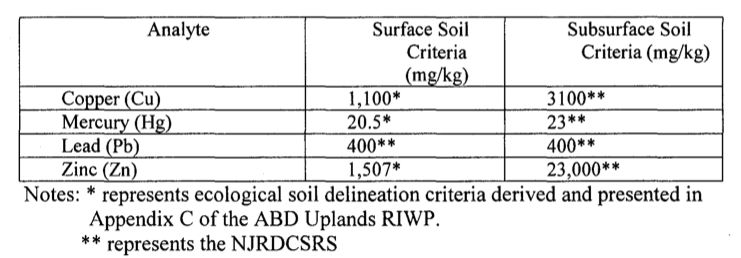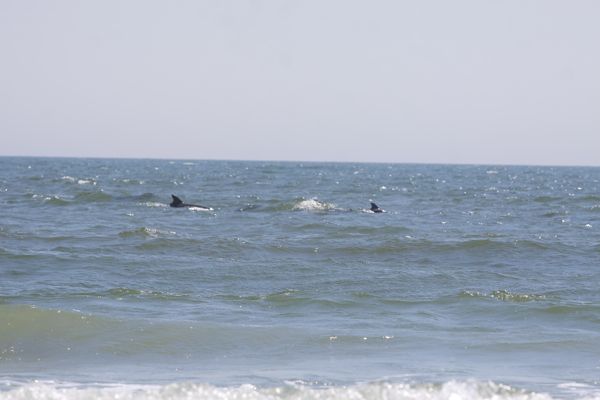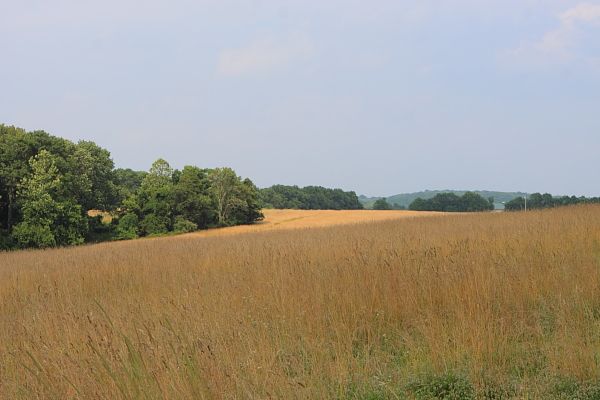EPA Issues Revised Dupont Pompton Lakes Cleanup Plan
EPA eliminated numeric 2 ppm ecological cleanup standard for sediments
EPA backed off requirements for Hot Spot removal and Ecological Risk Assessment
Whitewashed USFWS Criticism of Dupont Science & EPA Legal Error that triggered Dupont appeal
[Update: 11/6/14 – Leslie Scott at Suburban Trends writes a good story, see:
EPA releases third cleanup plan for Pompton Lakes
Bill Wolfe, director of New Jersey PEER (Public Employees for Environmental Responsibility), said the EPA is letting DuPont off the hook for potentially millions of dollars in natural resource compensation damages.
He said, “While the EPA is not legally responsible for assessing and collecting natural resource damages … an ERA is a critical scientific study that documents, among other things, the need for additional cleanup and the need to compensate the public for injuries to natural resources. The 2014 version leaves it up to EPA to decide, at some future point, based on future monitoring and sampling, whether an ERA is required.”
Wolfe added that DuPont has had the benefit of closed-door negotiations that allowed a reduced cleanup size, delayed the cleanup by two years, and changed the cleanup standards to be “flawed and lax.”
Wolfe said abandoning the older standard “puts more control over cleanup in DuPont’s hands, which raises oversight and enforcement concerns.” – – end update
[More Updates below]
US EPA today issued the long overdue revised draft permit for the Dupont cleanup of Pompton Lakes sediments, upland portions of the lakefront, and downriver portions contaminated by toxic mercury.
I issued the following statement, because press seem in a big hurry to do the 24 hour news cycle superficial review. It will take me awhile to get this all documented and linked correctly. Plenty of time, the public hearing is not until *December 8, and comment period ends on December 18, 2014
NJ PEER issued the following statement on the draft RCRA Corrective Action permit EPA released on Oct. 30, 2014:
We are pleased that EPA has finally re-issued a draft Dupont RCRA permit that would require cleanup of a portion of Pompton Lake sediments and downstream areas that Dupont poisoned with toxic mercury and other hazardous substances including lead, and selenium. The permit and cleanup are along overdue
We have 6 specific concerns, based on preliminary review of the draft permit:
1) EPA whitewashed controversial history – USFWS critical review drove expansion of original draft cleanup plan
Before we get to the merits, briefly, we need to summarize the permit chronology:
- On November 20, 2011, EPA published a public notice for a draft permit modification, which proposed final remedy selection for the ABD sediments, the Upland Soils, and the Shoreline Properties
- A public hearing was held during the public comment period on January 5, 2012 at the Pompton Lakes High School, at which approximately 32 persons provided comments
- Under federal RCRA regulations, EPA is required to consult with US Fish and Wildlife Service in drafting the permit. They failed to comply with this consultation requirement.
- On February 9, 2012, based on objections raised by NJ PEER at the public hearing, AFTER the public comment process, US Fish and Wildlife Service submitted scathingly critical comments on the Dupont science EPA relied on
- To address and as a result of the USFWS concerns, EPA expanded the scope of the cleanup in the draft permit from 26 acres to 40 acres.
- Dupont challenged the EPA’s December 2012 final permit before the EPA Environmental Appeals Board. Dupont’s major challenge was to the change EPA made expanding the draft permit cleanup in the final permit.
The EPA permit documents ignore this history which shows two important things: a) that Dupont’s science was flawed, according to USFWS; and b) EPA made a huge legal error in expanding the permit from draft to final form.
EPA used the SAB process to negotiate new cleanup plans behind closed doors. This was not a transparent process subject to public review and input.
Accordingly, we will closely scrutinize the changes made between the final 2012 permit and the draft 2014 version.
While we have not yet conducted that detailed review, based on preliminary review we have a few troubling concerns
2. The cleanup is less stringent than EPA proposed in 2012 permit that was challenged by Dupont
Here is what the 2012 version required, according to an EPA 12/19/12 press release (boldface mine)
“Under the permit modification, the EPA will require DuPont to dredge at least 100,000 cubic yards of mercury contaminated sediment from the bottom of a 40-acre area of Pompton Lake and remove at least 7,800 cubic yards of contaminated soil from a shoreline area of the lake affected by DuPont’s past discharges”
The scientific basis for that cleanup was stated in the 2012 permit as follows: (boldface mine):
“An expanded ABD sediment removal program requiring removal of all sediment down to the peat layer in an expanded area from the mouth of the Acid Brook to a line nearer to the Ramapo River channel, running approximately north-south, and coinciding with the 2 ppm surficial mercury concentration contour line. This expanded area encompasses approximately 40 acres as compared to the originally proposed 26 acre dredging area.
However, today’s EPA’s press release and revised version of the permit mention 36 acres – not 40 acre as – an say nothing about a minimum of 100,000 cubic yards requirement.
3. EPA abandoned the 2 ppm cleanup standard – this puts more control over cleanup in Dupont’s hands and which raises oversight and enforcement concerns
The 2012 version was based on a numeric and enforceable 2 ppm “site specific ecological cleanup criteria”.
Here is EPA 2012 statement of basis of RCRA permit: (for Lake dredge, boldface mine)
“An expanded ABD sediment removal program requiring removal of all sediment down to the peat layer in an expanded area from the mouth of the Acid Brook to a line nearer to the Ramapo River channel, running approximately north-south, and coinciding with the 2 ppm surficial mercury concentration contour line. This expanded area encompasses approximately 40 acres as compared to the originally proposed 26 acre dredging area.”
That 2 ppm cleanup standard has been eliminated in the 2014 version and replaced by a “qualitative” approach that lacks effective enforcement.
Here is EPA 2014 statement of basis of RCRA permit (for lake dredge)
“There are no promulgated applicable remediation standards for sediment to use as quantitative RAOs. However, narrative qualitative RAOs have been developed to set goals for protecting human health and the environment in the PLSA.”
4. The Dupont proposed upland soil cleanup standard is flawed and not protective
Although EPA rejected a numeric standard for lake sediment cleanup, EPA has allowed Dupont to cleanup upland soils to a flawed and lax standard of 20.5 ppm. That Dupont derived standard is not a promulgated applicable standard, just like the sediment 2 ppm standard in the 2012 permit. Dupont can’t have it both ways – if EPA can’t enforce the 2 ppm sediment standard because it was not a promulgated applicable standard, then they can’t be allowed to use their own derived 20.5 ppm soil cleanup standard.
That is 10 times higher than the original 2012 sediment cleanup standard o 2 ppm – and based on questionable assumptions about soils, methylization of mercury, and bio-accumulation.
[Update – here is the flawed basis for deriving the 20.5 ppm soil standard, from the June 2013 Onsite Soils Corrective Measures Study:
2.2 Application of Soil ERGs for Protection of Wildlife Receptors
In determining compliance and protectiveness of wildlife receptors, the type of soil (hydric vs non-hydric) needs to be considered. The soil ERG derived for mercury, which was based on uptake and exposure to inorganic forms of mercury, may not be applicable in hydric soils where the production of methylmercury, a more toxic and bioaccumulative form, is likely greater relative to upland soils (Selvendiran et al., 2008; Skyllberg et al., 2003; St. Louis et al., 1996; Rudd, 1995). Soil ERGs derived using the approach described in the preceding sections are intended for application to upland (i.e., non-hydric) soils within the EMA, NMA, WMA where habitat exists and ecological pathways are complete. The soil ERG derived for mercury, which was based on uptake and exposure to inorganic forms of mercury, may not be applicable in hydric soils where the production of methylmercury, a more toxic and bioaccumulative form, is likely greater relative to upland soils (Selvendiran et al., 2008; Skyllberg et al., 2003; St. Louis et al., 1996; Rudd, 1995).
5. Dupont has benefitted by delay and closed door negotiations
Dupont has benefitted from challenging the 2012 permit – these benefits include:
- a *3 year delay
- elimination of the 2 ppm sediment cleanup standard
- a smaller area of the lake to dredge (36 acres versus 40 in 2012 permit)
- relief from Hot spot cleanup and NRD assessment and compensation
6. EPA letting Dupont off the hook for Natural Resource Damages (NRD)
EPA backed away from the 2012 permit condition that required that Dupont conducting an Ecological Risk Assessment (ERA).
While EPA is not legally responsible for assessing and collecting natural resource damages (that is USFWS’ and NJ DEP’s job), an ERA is a critical scientific study that documents, among other things, the need for additional cleanup and the need to compensate the public for injuries to natural resources.
EPA should be working with USFWS – who indicated back in Feb 2012 that they were considering a NRD and talking to Dupont. Here’s what USFWS consultation stated:
“The Service does not believe that the proposed remedial action, as currently planned, will completely address historical releases nor be sufficient to protect again future injury to Federal Trust resources from residual contamination originating from the PLW…. The Service may consider performing a Natural Resource Damage Assessment (NRDA) to evaluate injury to Trust resources from historical exposure and residual contamination following the proposed remedial action, and we have initiated contact with the Applicant in that regard.” (emphasis mine)
The 2014 version leaves it up to EPA to decide at some future point, based on future monitoring and sampling, whether an ERA is required.
Here is the loophole – failure to sample fish, birds and bats that bioaccumulate the highest levels of mercury:
Select exposure media included sediment, pore water, larval midge tissue, adult midge tissue, and spider tissue; broader ranging receptors evaluated in the 2013 Ecological Investigation, including fish, birds, and mammals were not included in the evaluation due to the greater spatial range of these receptors and the uncertainty in attributing exposure to specific sampling stations.
This is a formula for letting Dupont off the hook for potentially millions of dollars in NRD damages.
Look at the species sampled to assess bioaccumulation – midge and spider:
[Update: 10/31/14 – We will need to remind USFWS and US EPA about their own science on this point:
An inter-agency committee (NJDEP, USEPA, and USFWS) was assembled to derive New Jersey-specific wildlife water quality criteria for DDT and its metabolites, mercury, and PCBs that would minimize adverse effects of these pollutants on the bald eagle and peregrine falcon. The dwarf wedgemussel was not included in the calculation of water quality criteria for the protection of wildlife because of its lower trophic level, the danger of contaminant biomagnification should be less than with a higher trophic level organism in the food chain. As indicated in the inter-agency committee report on derivation of the wildlife criteria, the State’s aquatic life-based criteria are intended to provide the necessary level of protection for these mussels. Recognizing that the GLWQI criteria were developed using information gathered from the Great Lakes, which may not be directly transferable for use in New Jersey for several reasons (see Derivation of New Jersey-Specific Wildlife Values as Surface Water Quality Criteria for: PCBs, DDT, and Mercury, July 2001 at www.state.nj.us/dep/wmm/bfbm/sgwqt.html), the inter-agency committee derived New Jersey-specific criteria. The bald eagle, peregrine falcon, and osprey were selected as representative species for calculation of New Jersey-specific Wildlife Values. The bald eagle and peregrine falcon are classified as endangered species, and the osprey a threatened species on New Jersey’s threatened and endangered wildlife list. Wildlife Values were calculated for each of these species using an equation developed under the GLWQI (see below). The majority of the input and species-specific exposure parameters used to derive the criteria for PCBs, DDT and its metabolites, and mercury were based on the GLWQI. These included test dose, uncertainty factors, amount of water and food consumed, and the average weight of the animals. Bioaccumulation factors (BAFs) were based on work subsequent to the GLWQI and the use of New Jersey-specific values for dissolved and particulate organic carbon.






